A Culinary Canon: From St. Lucia to Louisiana
Stories and recipes from a Caribbean chef’s travels
By Nina Compton with Osayi Endolyn
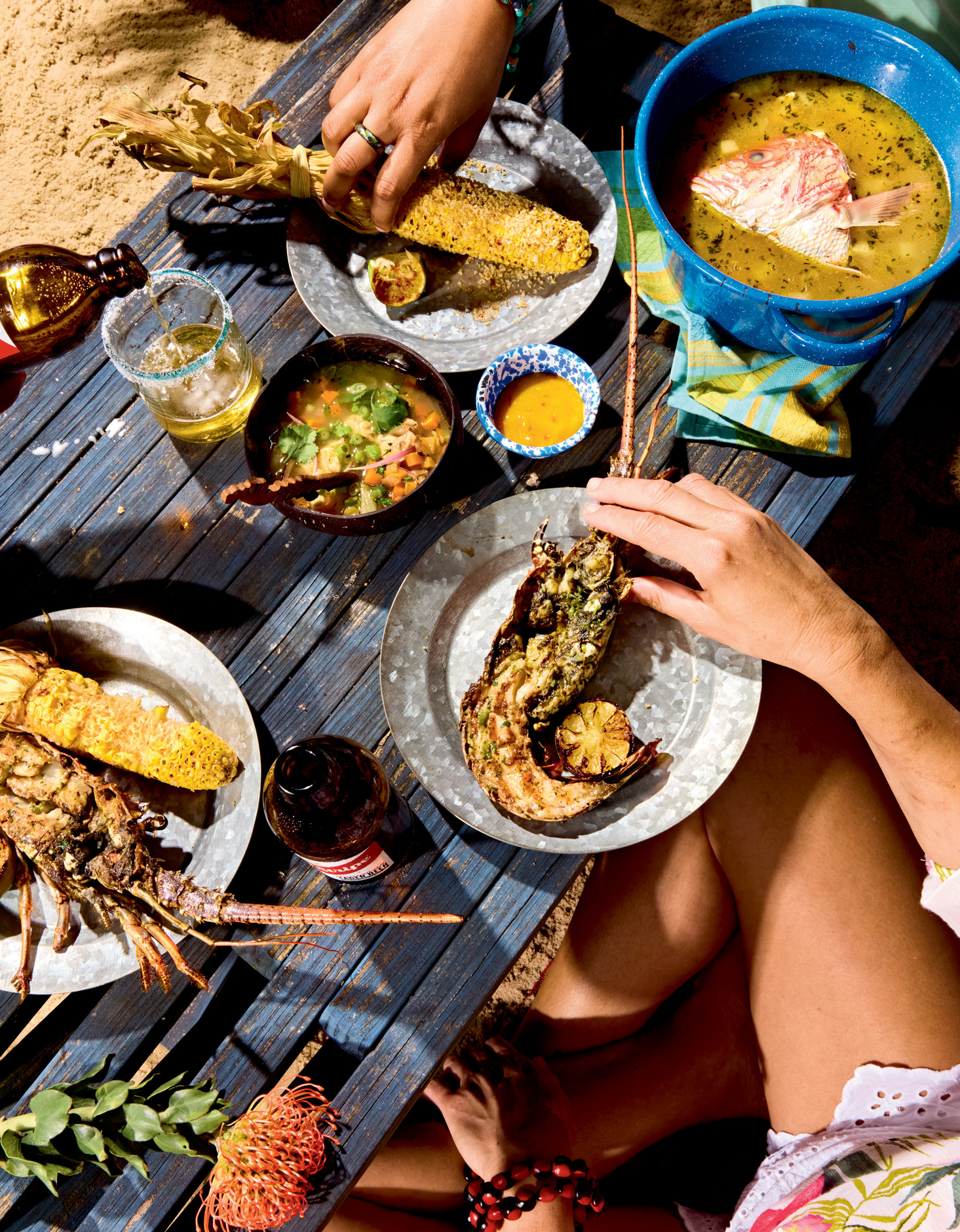
Photograph © 2025 Brittany Conerly. All images from Kwéyòl / Creole: Recipes, Stories, and Tings from a St. Lucian Chef’s Journey by Nina Compton with Osayi Endolyn © 2025. Courtesy Clarkson Potter/Penguin Random House
Editor’s Note: The following words and recipes come from Kwéyòl / Creole, a new book that follows Nina Compton from her childhood in the Caribbean to the opening of her beloved restaurants in New Orleans. Written by Compton with Oxford American contributor Osayi Endolyn, the book illustrates how each section of the St. Lucian chef’s meandering journey—which includes, among other things, a pit stop in a Jamaican dancehall and a successful stint on reality TV—has contributed to the way she thinks about food, and people, and the world.
New Orleans
The producers of Top Chef called me up one day—it seemed like it was out of the blue. At that point, I was fifteen years into my cooking career. I loved living in Miami. I’d nailed down executive-level roles at celebrated spots, I had my staff, I had my cute little beach life, enjoying morning croquetas by the Atlantic Ocean before work. But after more discussion, I started to consider it. What if I could get on this show? The producers put us through multiple rounds of interviews. The last week, about two months after their initial invitation, they finally revealed the location to me.
Suddenly I was roommates with a bunch of chefs I’d never met before in a beautiful house on Bourbon Street in the French Quarter. I didn’t know anything about New Orleans while growing up in St. Lucia. But when I arrived as a TV show contestant in 2013, it felt more like being in the islands than I could have imagined. The bright-colored cottages reminded me of the Caribbean. Folks cultivate community through food, and they strive to eat well. A stranger across the bar may try to share a spoonful of their crawfish bisque with you for no other reason than because that soup makes them so happy, they want someone else to experience it.
At first, I had my guard up during the filming. I was thinking, Hey I’m just little Nina from the islands trying to cook my Caribbean food. I felt completely out of place. We’d be asked to report for filming and be greeted with something like: “Today you’re going to be cooking in the swamp.” The show was incredibly stressful, even while it was exciting, because you know that your every error is going to be highlighted. But after a few challenges I realized I was sticking around, and I didn’t have to perform crazy techniques to stand out. I remembered that my cooking was about local ingredients, seasonality. I remembered that in Jamaica, the best cooks were those roadside vendors who made one thing well, over and over.
I ended Top Chef as the runner-up. For my final challenge, I cooked roasted goat with orecchiette pasta, and a chocolate zeppole with passion fruit crème anglaise. I was proud and happy with my dishes. My mum would tell me, week to week, that people in St. Lucia were making t-shirts with my face on them and were having viewing parties. For the finale, St. Lucia’s capital, Castries, shut down the main square and projected it on a big screen.
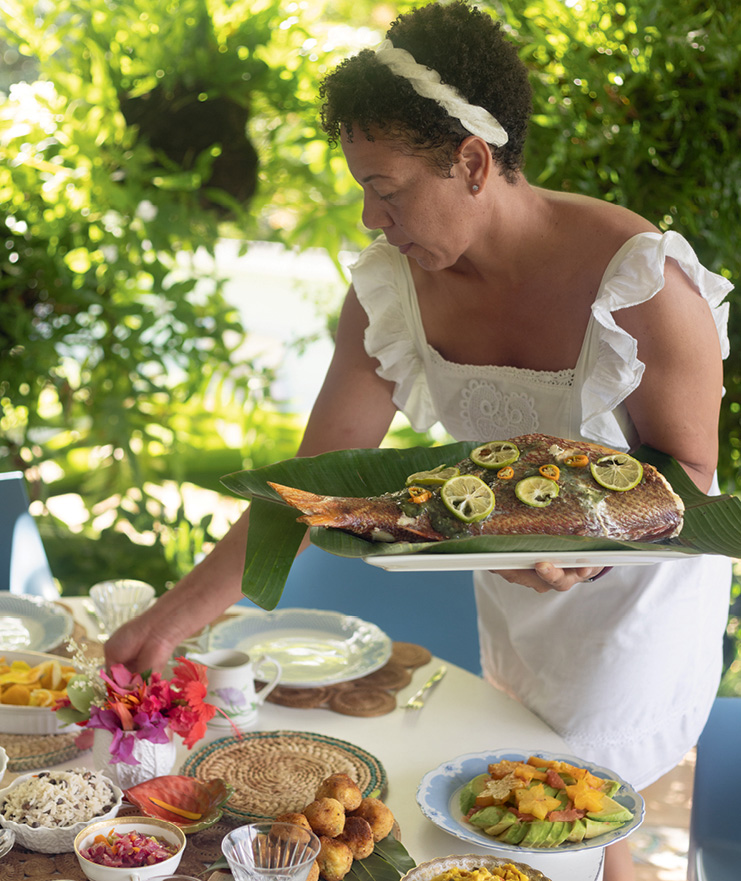
Photograph © 2025 L. Kasimu Harris
Being on Top Chef changed my life. The show introduced me to New Orleans, and I found my culinary voice after all these years. I’d finally developed the confidence to cook my food. Returning to Miami after the show finished taping, I was clear that I needed my own place. I looked for a restaurant space all over Miami, but nothing clicked. But then the call came to open in New Orleans’s warehouse district.
I opened Compère Lapin in 2015 with dishes like curried goat, drawing from home; conch croquettes inspired by Miami’s Cuban croquetas; and buttermilk biscuits, the local dinner bread. We showcased Gulf seafood with shrimp in rundown sauce, a flex from Jamaica, and crudos that played off ceviche recipes I learned from my cooks in Miami, and we fried whole fish. Our vegetable dishes reflect what I can get in South Louisiana, and they reflect the best of the season, like mirliton and carrot slaw.
I live in the Bywater neighborhood in New Orleans. My mum and my sister Fiona gave me two banana plants to have in my backyard. That’s symbolic of St. Lucia, our prized crop for generations. My mum said you should always have ginger and turmeric in your garden. So, a lot of ginger and turmeric is in my garden. I’ve got fresh herbs growing, like rosemary, parsley, and basil. A woman down the street sells sno-balls and pralines. Another guy has a pickup truck setup, and he makes rotisserie chicken to sell. The aroma is so good.
Folks in the know order my interpretation of cow heel soup, with its rich broth scented with ginger, lemongrass, and peppers. Back home in St. Lucia, the soup is a beloved classic sold at the local Saturday market. It’s robust in flavor and resourceful in ingredients. Every bite counts.
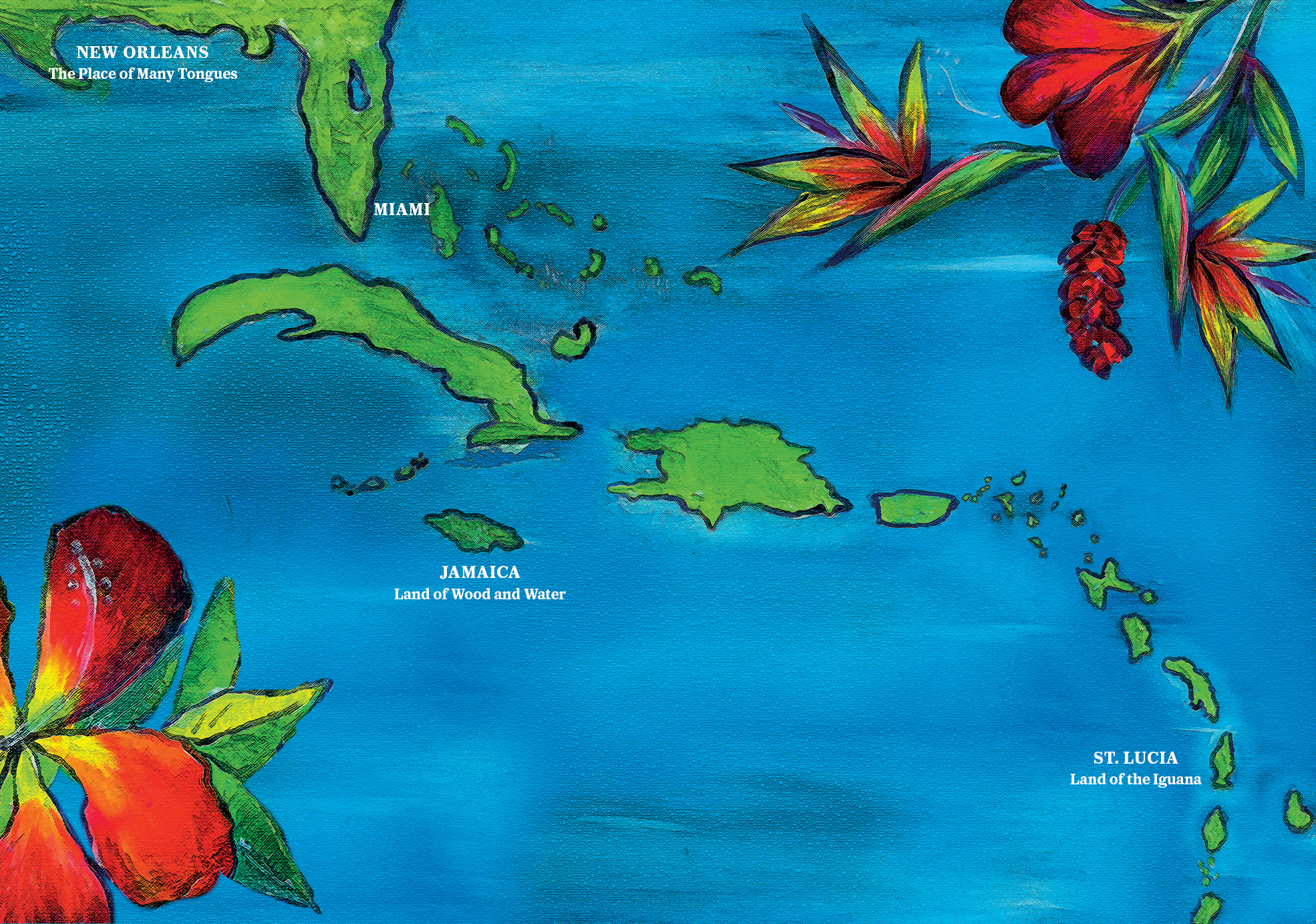
Map illustration by Fiona Compton
Moulin à Vent
I’m from a quiet, hilly region of St. Lucia called Moulin à Vent, which means windmill in French. We had an old windmill next to our house, which was used to process sugarcane many years ago. Nearby is Gros Islet, a small fishing town. You can see the fishermen go out in the mornings and come back in the evenings. Whenever we’d go to the beach, I’d see this guy on a small boat, which he adorned with flags from all over the world. The boat was practically drowning in flags. He sold fresh fruit to folks relaxing on their boats. He’d blow his conch shell to announce oranges, grapefruit, or mangoes. Usually he’d come to the shoreline, and we’d get a bag of fruit, which he’d cut for us right there. My childhood is defined by that salty, sweet flavor—the ripe fruit mixed with the briny mist of ocean water. I’ve always liked to be surrounded by the water.
I was born to Janice and John Compton, the fourth of five children. My father, Sir John Compton, would eventually become the first prime minister of an independent St. Lucia in 1979. My mum was born in St. Lucia to my English grandmother and my St. Lucian grandfather. My grandmum (Granny) used to tell me how she adapted to St. Lucia in the 1940s, then still under British colonial rule (and at other periods, the French; they each ruled my country seven times over the centuries). When I was little, I acted as her sous chef for the easygoing lunches we enjoyed as a family. I helped cut the onions and peeled garlic.
On the weekends, my four siblings and I would head down to the countryside with my dad to Mahaut, where he farmed. That was my dad’s escape from his career in law and politics. He loved working the land. He went to the farm weekly, harvesting whatever he could. When we visited with him, we’d hang out by the river, which was just down the hill. The water was chilly, but we didn’t care. We’d climb the rocks and catch crayfish. We’d try to catch fish with our hands, but they were too fast.
My backyard had every fruit tree I could think of; it’s crazy that it seems special now, that you could pick fruit that grows for free. We had guava, lime, lemon, and passion fruit. We’d come home from school, take off our uniforms, and play for hours in the garden. We had three guava trees in a perfect line in front of our house. We’d play gymnastics, pretending the guava trees were uneven bars, because the branches were long. Mrs. King, a lady who lived near my school, would make patties (Caribbean-style Cornish pasties). There we were, all these kids—a typical Caribbean scene of boys and girls in school uniforms, socks up to our knees, racing to get a snack during the midday break. Mrs. King made patties with roast chicken, potatoes, peas, or corn, then folded them over and baked them. It was just a thing you had to get, that and her iced lollies—little bags of frozen, sweetened condensed milk with food coloring. We all knew her by these treats.
Family travel consisted of short road trips to the south of the island to visit the rainforests. The roads are winding and curvy, and we drove slowly. On the ride there, I’d bounce around the back of my father’s pickup truck, high-fiving banana tree leaves with my sister. Upon arrival, we’d have a riverside lunch with fresh fruit, sandwiches, maybe stewed chopped pork with rice and beans. This part of the country is dense with vegetation. More traditional cooking happens here. More green figs, more pigtails. If you want to feel St. Lucia at its core, head south. I think the same is true in the United States.
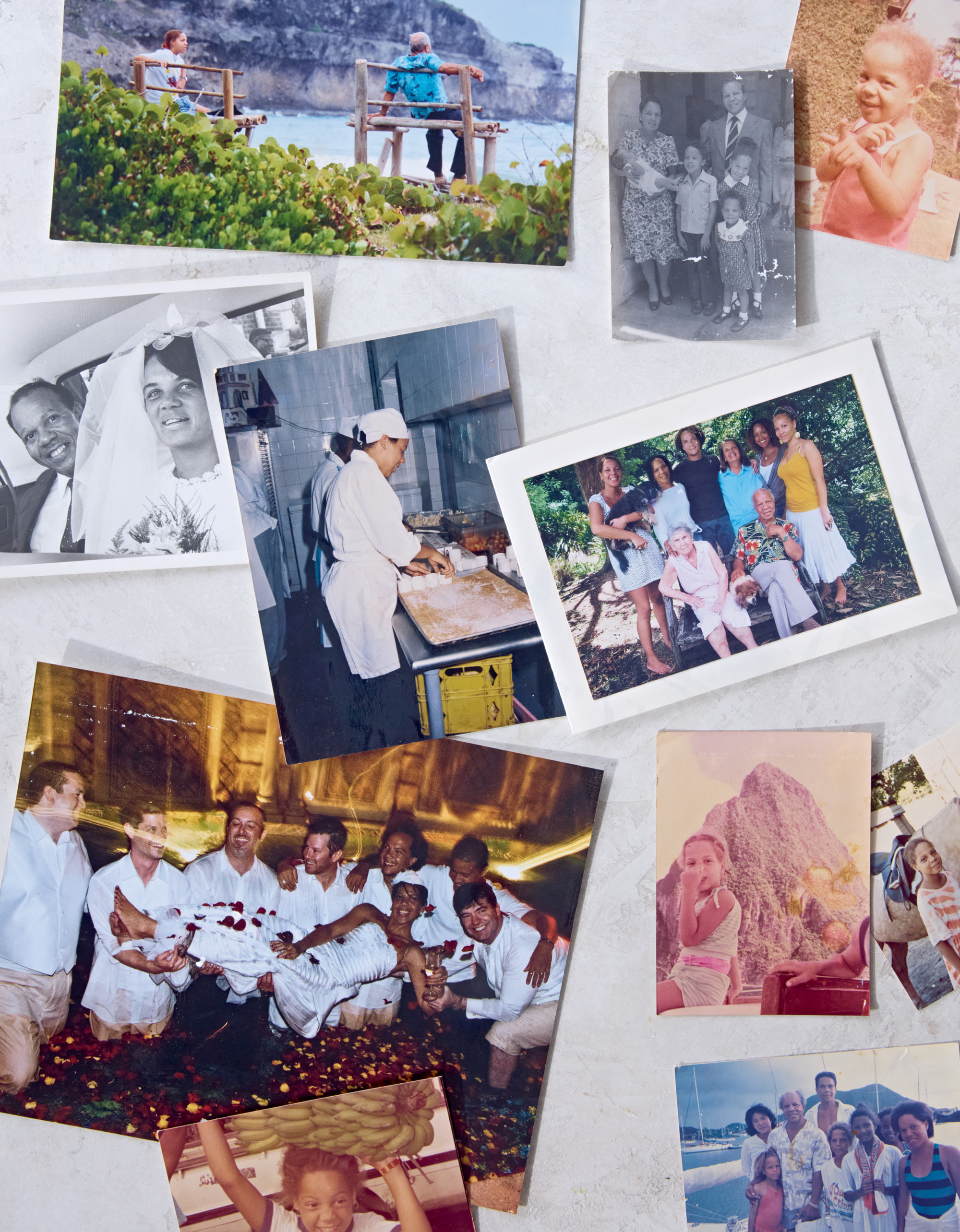
Photographs from Nina Compton’s personal collection
Montego Bay
Ithink I had ackee every day that I lived in Jamaica. It was often sautéed with peppers and onions. Breakfast in the Caribbean is hearty. In St. Lucia, it’s green fig and saltfish or saltfish with steamed dumplings. In Jamaica it’s ackee and saltfish. I’d often have a lunch of ackee, callaloo, rice and peas, and steamed vegetables. So much of what we eat in the Caribbean is connected to the plant-based diets our ancestors had in West Africa.
My restaurant education landed me more than one thousand miles away from home, in a hotel resort kitchen in Montego Bay, Jamaica. I worked with a woman named Rita; she was like an aunt to me. She took me under her wing, recognizing I was out of my element. Thank God for Rita! She’d break down the Jamaican patois for me and helped fast-track my fitting in. Every weekend she’d say, “We’re going to the bashment.” I’d only heard of these in reggae songs. When she picked me up, it was her and her daughter, and she wore a green one-piece leotard, neon green bob wig, green eyelashes, her nails done. Her daughter had on a white wig with white hot pants. I had no idea you had to be dressed in the freshest gear. I was in jeans, sneakers, and a t-shirt.
We went to a dancehall and I just watched. This was the height of the dancehall culture, and the focus was the DJs and beautiful women in custom outfits who’d dance opposite the DJ in competition. Separate from the performances, the crowd was moving nonstop. Different rhythms had different dances, and it seemed like everyone knew what to do when. Outside the venue, you’d see smoke plumes from folks roasting jerk chicken or barbecuing meats. Throughout the city, street vendors recycled old car parts and repurposed them as grills. I saw a lot of folks use a wheel spoke as their grill. They’d put together a stand and their coals, and they cooked dishes like stewed chicken with rice and peas. You saw them in these makeshift stalls along the street, along the coast, driving from Negril to Montego Bay. There was this guy called the Pudding Man. He had a dish you could compare to a tamale. It’s prepared with cornmeal and then steamed.
What I love about Caribbean people, their focus is on making one thing. You perfect your craft in that one offering and you do it well. You’ll see Miss Jones do a stewed chicken on Fridays and Saturdays from her house. And when she sells out, she sells out.
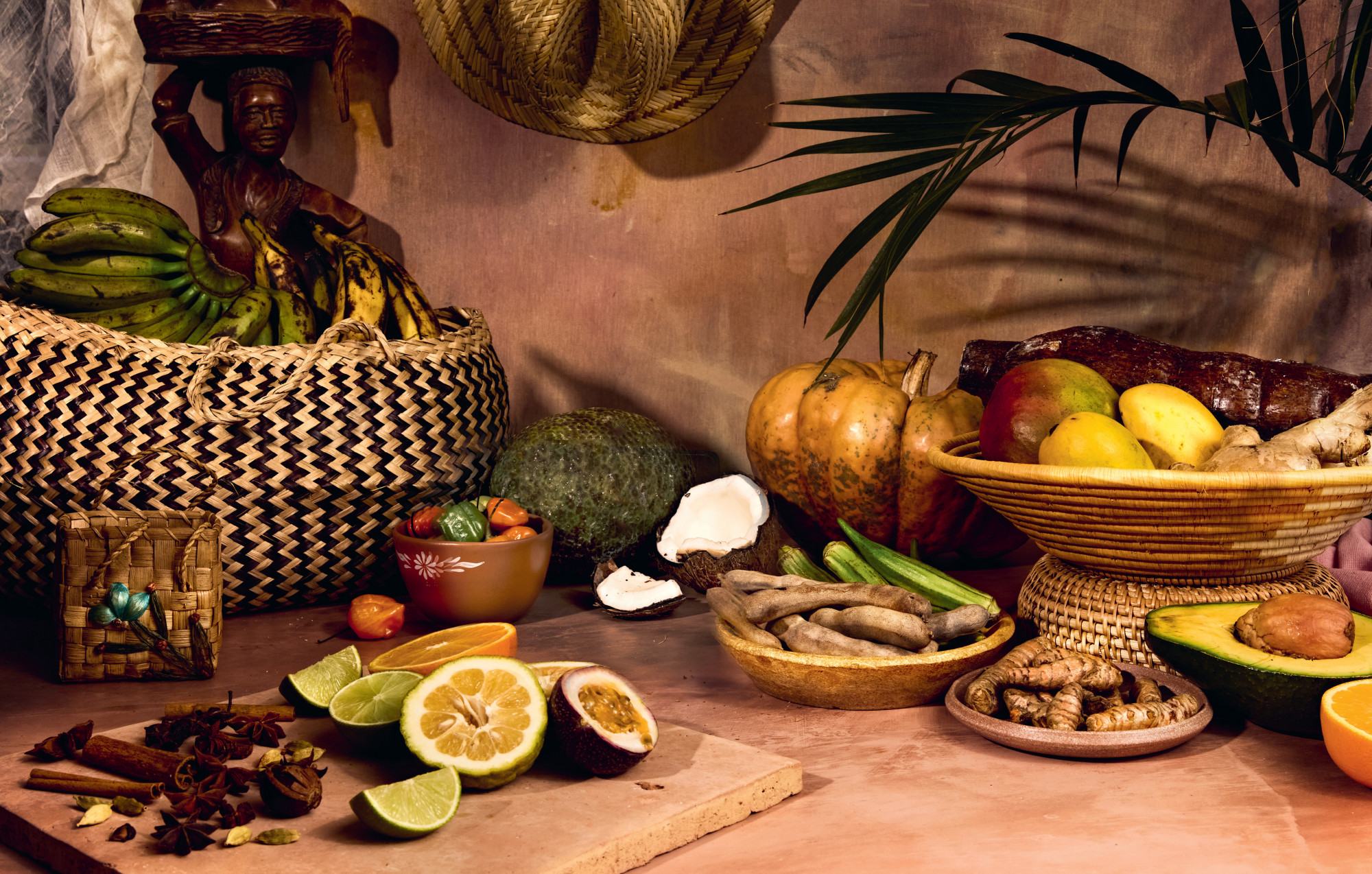
Photograph © 2025 Brittany Conerly
Miami
Iwas naive; I thought all of Miami was like South Beach. The drive to the beach was long, and the traffic was horrific. I wasn’t making friends, because I wasn’t meeting people, and the city was spread out, so it was hard to know where to go if you didn’t know where to go.
Culinary school in New York was my revelation that cooking could take me to places farther than I’d dreamed of, but after I finished school and worked a few months in a fine dining French restaurant, I didn’t want to stay. I decided to head to Miami, where my sister Maya had been living. My sister was married, had a child, and was living that suburban life outside the city—definitely not the routine I’d imagined. I hated it at first.
Ten months into my time, though, Miami Carnival popped up. Suddenly I was around my people! This was my first time seeing the many Caribbean folks in the city socializing and creating an authentic Caribbean vibe. That flipped the switch. I was able to get a couple of jobs off the extension of my student visa, one of them working in Norman Van Aken’s namesake fine dining Latin Caribbean restaurant. Norman was cooking with ingredients I knew from my background, like yuca (cassava to me) and conch, and he was doing intricate preparations with ingredients foreign to Caribbean repertoire. He had a cracked conch chowder where the conch was sliced thin and lightly breaded. The bright yellow broth was a base of clams and mussels, with orange juice, Scotch bonnet, saffron, star anise, and coconut milk. He made a puree with yuca, stuffed it into shrimp, then breaded and fried them.
Deconstructing ingredients, using precise knife cuts, and using wine as a fortifying ingredient were all new ways of eating these foods I’d grown up with. At the time, I was excited about what could happen in my hands with this knowledge. I wanted to be inspired by the American innovation I was witnessing, but I didn’t want to lose the essence and respect I had for my Caribbean heritage. Often in the chef world, we use the word “elevated” to describe this kind of food, but my cookbook co-writer Osayi Endolyn has challenged me that this echoes colonial ideas.
Our food is already elevated, she told me as we worked on my book; that’s why chefs like Norman were reaching for it!
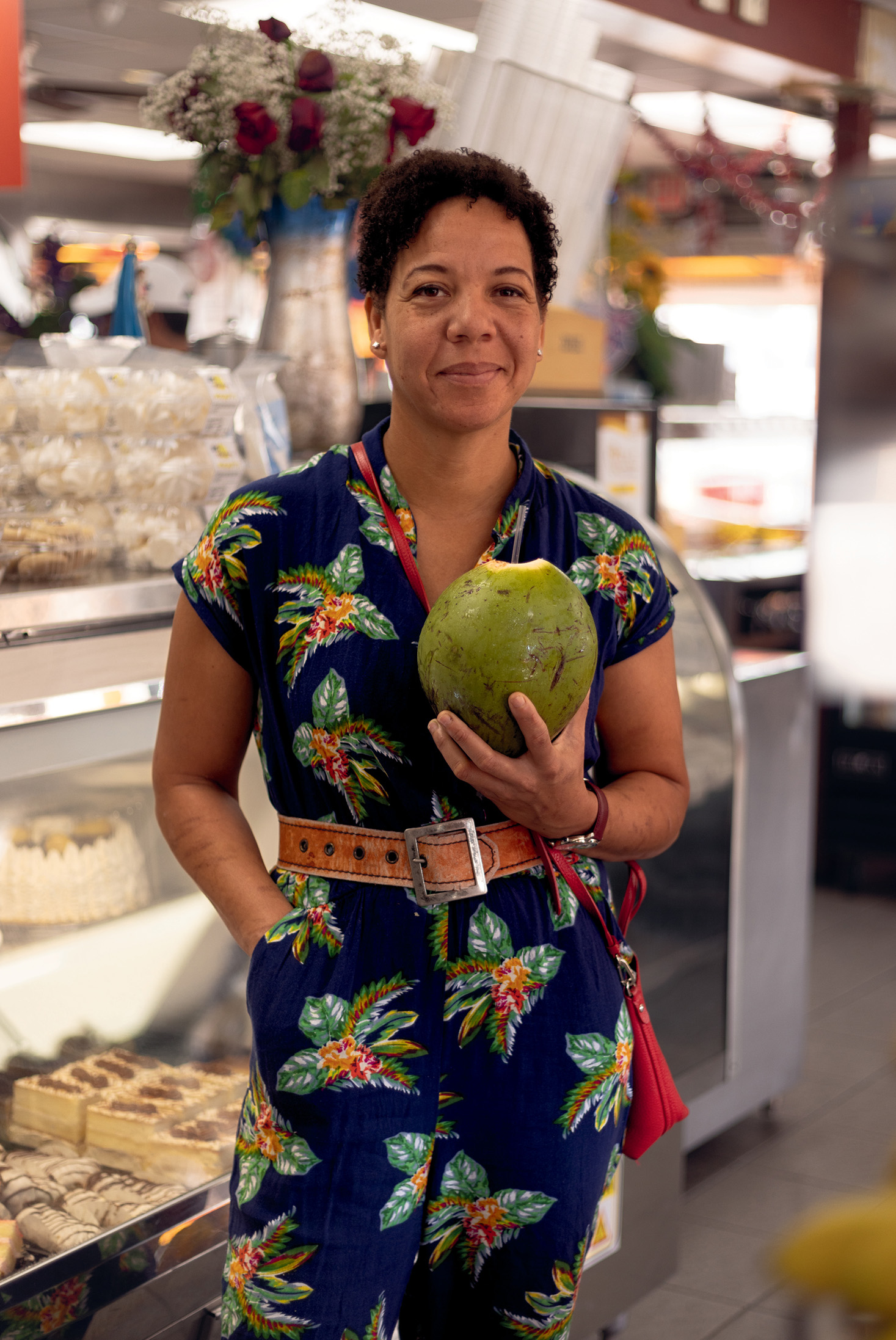
Photograph © 2025 L. Kasimu Harris
SWEET POTATO GNOCCHI
SERVES 6 TO 8
For this recipe, I connected the root vegetables that I grew up with to the local culture of New Orleans. Sweet potatoes are all over the American South, and their sweet, subtle flavor makes them easy to incorporate in different preparations. Pasta became my therapy when I was working in Miami—I loved forming gnocchi by hand. I serve this style of gnocchi with curried goat at Compère Lapin, and it’s become a definitive dish for the restaurant.
3 pounds sweet potatoes (such as Garnet)
¼ cup kosher salt
4 large egg yolks
4 cups all-purpose flour, plus more for dusting
½ cup semolina flour, for dusting
COOKING THE GNOCCHI:
1 cup kosher salt
Sauce of your choice
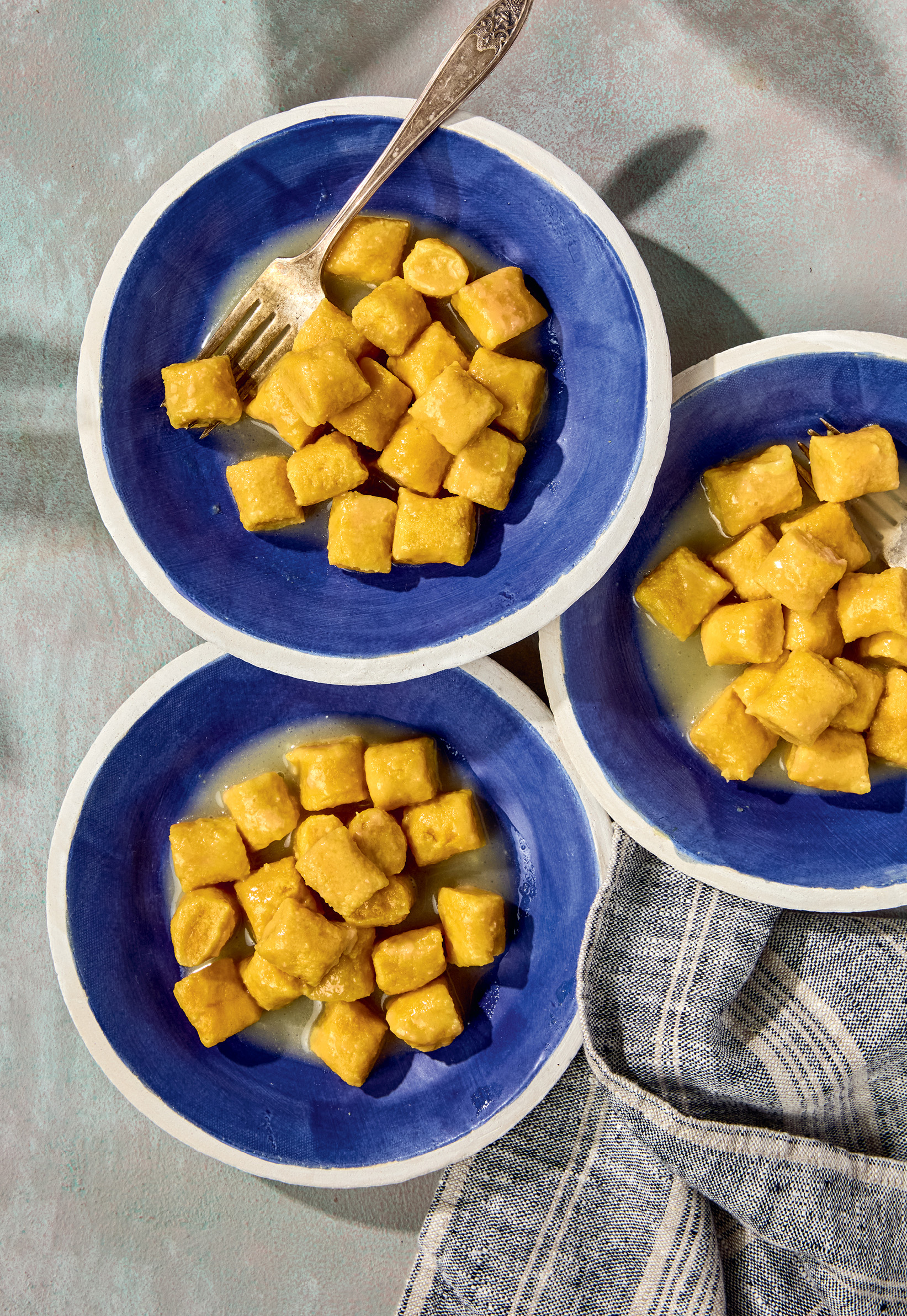
Photograph © 2025 Brittany Conerly
Heat the oven to 375°F. Fit a sheet pan with a roasting rack.
Place the sweet potatoes on the roasting rack and bake them until fork tender, about 1 hour. Set aside to cool.
When the potatoes are cool enough to handle, peel off the skins, then transfer the flesh to the bowl of a stand mixer fitted with the paddle attachment. On medium speed, blend until smooth, 10 to 12 minutes. Add the salt to the mixture.
Add the yolks to the blended sweet potatoes and mix on low speed until smooth, about 3 minutes. Gradually add 3 cups of the all-purpose flour, 1 cup at a time, until the dough comes together, about 1 minute. It should be smooth, cohesive, and not tacky to the touch. Water content in sweet potatoes can vary, so add the flour slowly and watch the consistency; you may not need all the flour. Don’t overwork the dough.
Scoop the dough into a piping bag and cut off ½ inch at the tip. (If you don’t have a piping bag, use a large zip top bag and trim about ½ inch off one corner to create a small opening to pipe the dough through.) Sprinkle a clean work surface with the remaining 1 cup of all-purpose flour, using your fingers to spread it around.
Pipe the dough mixture onto the floured work surface, forming logs about 6 inches long. Pinching flour from your work surface, dust the top of the gnocchi logs, then use your flattened palm to gently pull the gnocchi toward yourself, ensuring that the log is fully formed and covered in flour. This prevents the pasta from sticking together when you cut it.
Using a dough cutter or knife, divide the logs into 1-inch pieces. Dust a sheet pan with the semolina and a bit more all-purpose flour. Arrange the gnocchi on the floured sheet pan, then place it in the freezer for 1 hour. (If you want to hold off on cooking the gnocchi until later, you can freeze the cut pieces overnight on the sheet pan, then transfer them to zip top bags or an airtight container for up to 30 days.)
Cook the gnocchi: In a large stockpot, bring 4 quarts of water to a boil. Add the salt. Yes, the whole cup! You want the water to taste a little less salty than the ocean. Meanwhile, in a large saucepan, bring the sauce to a simmer. Working in batches so as not to overcrowd the pot, add the gnocchi to the boiling salted water. Maintaining high heat, cook the pasta until the gnocchi floats for about 1 minute, about 4 minutes total. Remove the gnocchi with a slotted spoon and add to the sauce. Repeat with the remaining gnocchi. Simmer the pasta and sauce together for about 1 minute to bring it all together. Serve immediately.
ACKEE FRITTERS
SERVES 4
Jamaica is the only island in the Caribbean that uses ackee to its fullest potential, despite the tree being found throughout the region. The texture is like uni (sea urchin) when you cook it; it feels silken and luxurious on the palate. Every Jamaican spot I’ve been to serves it. These fritters are big bites of flavor.
⅔ cup all-purpose flour
2 teaspoons baking powder
1½ teaspoons kosher salt, divided
½ teaspoon freshly ground black pepper
½ cup chopped Spanish onion
1 red bell pepper, diced
1 tablespoon minced Scotch bonnet pepper
1 cup canned ackee, rinsed, drained, and crushed
1 tablespoon Baron West Indian Hot Sauce or Crystal Hot Sauce
1 large egg
¾ cup coconut milk
Canola oil, for frying
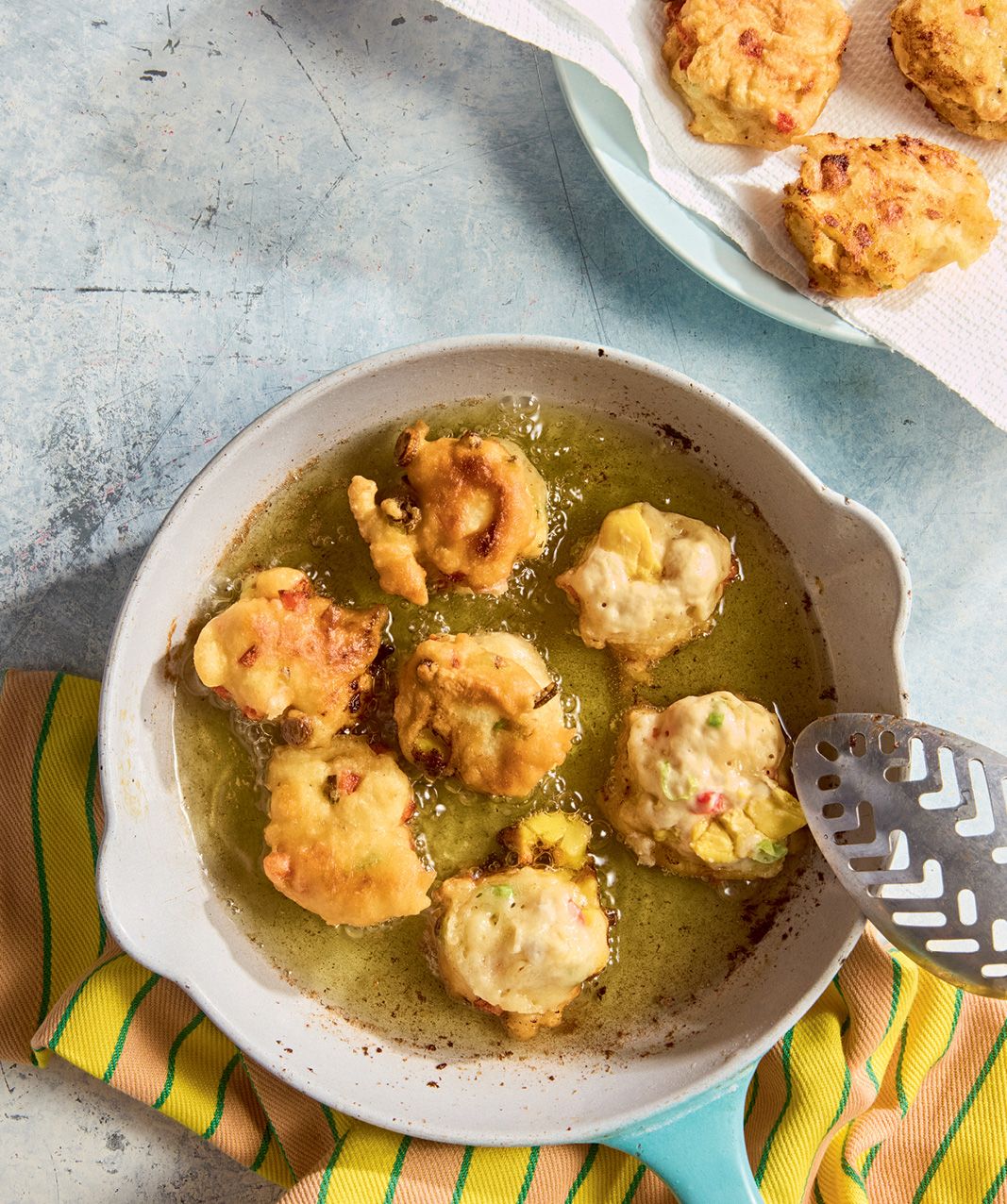
Photograph © 2025 Brittany Conerly
In a large bowl, sift together the flour, baking powder, ½ teaspoon of the salt, and the black pepper. Set aside.
In a medium saucepan on medium-high heat, add the onions, bell pepper, and Scotch bonnet pepper and sauté, stirring occasionally until tender, about 8 minutes. Season with the remaining 1 teaspoon of salt. Take off the heat and add the crushed ackee and hot sauce. Mix well.
In a small bowl, gently beat the egg and gradually add the coconut milk until smooth.
Transfer the vegetables to the bowl of seasoned flour. Stir gently to coat evenly. Add the coconut milk–egg mixture and fold in using a spatula. The mixture should look like a thick pancake batter.
In a large saucepan, add canola oil to a depth of 1 inch (about 2 cups) and heat on medium-high to 325°F; check using an instant-read thermometer. Line a plate with paper towels or fit a cooling rack in a sheet pan.
Use a tablespoon to scoop the batter and drop into the hot oil, repeating a few more times and taking care not to crowd the pan. Fry the fritters on both sides until evenly golden brown, about 3 minutes per side. Use a slotted spoon or tongs to remove them and set on the prepared plate to drain. Repeat with the remaining batter. Serve straight up, piping hot!
GREEN FIG AND SALTFISH
SERVES 4
This is the official national dish of St. Lucia. The indigenous green fig (our term for banana) combined with the imported salted cod became part of the diets of those living under colonial and enslaved rule for generations, and have been a mainstay ever since. Green fig and saltfish is a delicious and filling meal that we often enjoy for breakfast. It’s bright, acidic, fresh, and savory.
1 pound saltfish fillets
¼ cup coconut oil (or canola oil)
1 large yellow onion, minced
1 green bell pepper, coarsely chopped
3 garlic cloves, minced
4 seasoning peppers, thinly sliced
2 teaspoons thyme leaves
½ cup thinly sliced scallions
½ cup chopped fresh tomato (optional)
1½ teaspoons kosher salt, divided
1½ teaspoons freshly ground black pepper
8 green figs (these are green bananas—not plantains!)
1 tablespoon chopped flat-leaf parsley
GARNISH:
Florida avocado (or available avocado), sliced.
Cucumber, grated
This is the official national dish of St. Lucia. The indigenous green fig (our term for banana) combined with the imported salted cod became part of the diets of those living under colonial and enslaved rule for generations, and have been a mainstay ever since. Green fig and saltfish is a delicious and filling meal that we often enjoy for breakfast. It’s bright, acidic, fresh, and savory.
1 pound saltfish fillets
¼ cup coconut oil (or canola oil)
1 large yellow onion, minced
1 green bell pepper, coarsely chopped
3 garlic cloves, minced
4 seasoning peppers, thinly sliced
2 teaspoons thyme leaves
½ cup thinly sliced scallions
½ cup chopped fresh tomato (optional)
1½ teaspoons kosher salt, divided
1½ teaspoons freshly ground black pepper
8 green figs (these are green bananas—not plantains!)
1 tablespoon chopped flat-leaf parsley
GARNISH:
Florida avocado (or available avocado), sliced.
Cucumber, grated
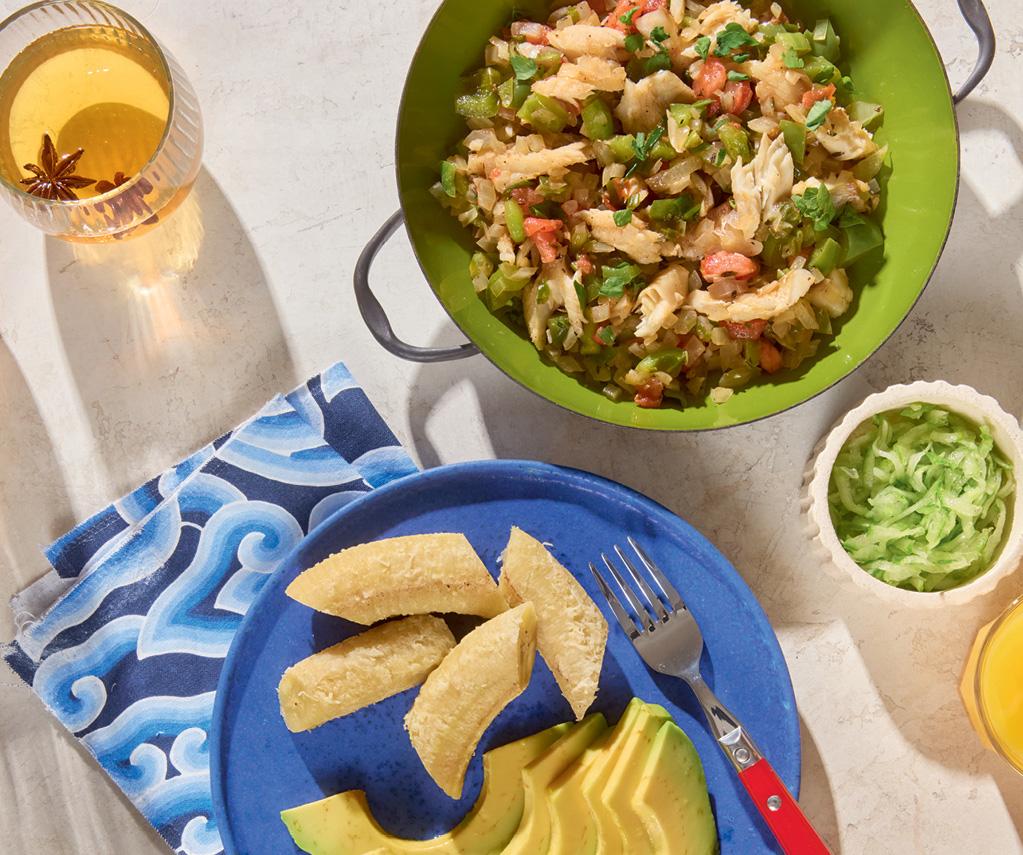
Photograph © 2025 Brittany Conerly
In a medium bowl, submerge the saltfish in water and leave to soak overnight in the refrigerator. Change the water at least once during the soaking time. Drain.
Let’s cook the excess salt out of the fish: Place the cod in a medium pot and cover with cold water by 2 inches. Bring the pot to a boil, then reduce to a simmer and cook for 20 minutes. Drain the fillets, return them to the pot, and repeat the boiling and draining process once more.
Transfer the fillets to a medium bowl. If needed, clean the saltfish by removing all skin, scales, and pin bones. Use a fork to flake it into large chunks, then set aside.
In a medium saucepan, heat the coconut oil over medium heat. Add the onions, green bell peppers, and garlic and sauté, stirring, until the vegetables are softened and fragrant, about 2 minutes. Add the seasoning peppers and stir, then cook until just incorporated, another 3 minutes. Add the flaked saltfish and thyme. Stir to mix thoroughly. Add the scallions and tomatoes (if using) and mix well. Season the mixture with 1 teaspoon of the kosher salt and the black pepper, then mix again. Set aside.
In a medium pot, bring about 2 quarts of water to a boil. Cut the ends off the green figs (green bananas). Make one lengthwise slice just through the skin. Place the green figs in the pot and boil until fork tender, about 15 minutes. Drain the water and allow the green figs to cool just enough to handle.
Remove the peels, using a small paring knife if needed. Dice the green figs into 2-inch cubes. Mix the green figs and the saltfish together. Taste and adjust the seasoning with the remaining ½ teaspoon of salt. Add the chopped parsley.
Garnish: Top with sliced avocado and grated cucumber. Enjoy hot. We serve this dish family style in the pot.
Excerpted with permission from Kwéyòl / Creole: Recipes, Stories, and Tings from a St. Lucian Chef’s Journey © 2025. Published by Clarkson Potter, a division of Penguin Random House, LLC.
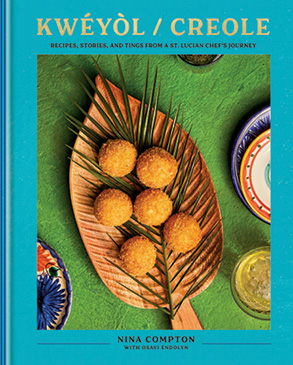
This story was published in the print edition as “Every Bite Counts.” Buy the issue this article appears in here.


